Honey gourami are a popular and delightful little tropical fish that add a bright splash of color to your aquarium. They’re hardy and fairly easy to care for, so they’re a great species for beginner aquarists.
The freshwater species is part of the gourami family – and this particular variety comes from Bangladesh, India, and Nepal originally.
You might find honey gourami under other names as well including sunset honey gourami, red honey gourami, red flame gourami, or sunset gourami.
If you’re interested in keeping some of these stunning, colorful fish, check out the care guide below to see the ins and outs for best care results.
Quick Intro to Honey Gourami
| Family: | Gourami |
| Scientific Name: | Trichogaster chuna |
| Other Names: | Honey DwarfGourami, Red Honey Gourami, Sunset Gourami, Red Flame Honey Gourami, Dwarf Fire Gourami |
| Care Level: | Easy |
Natural Habitat, Identification, and Where to Buy Honey Gourami
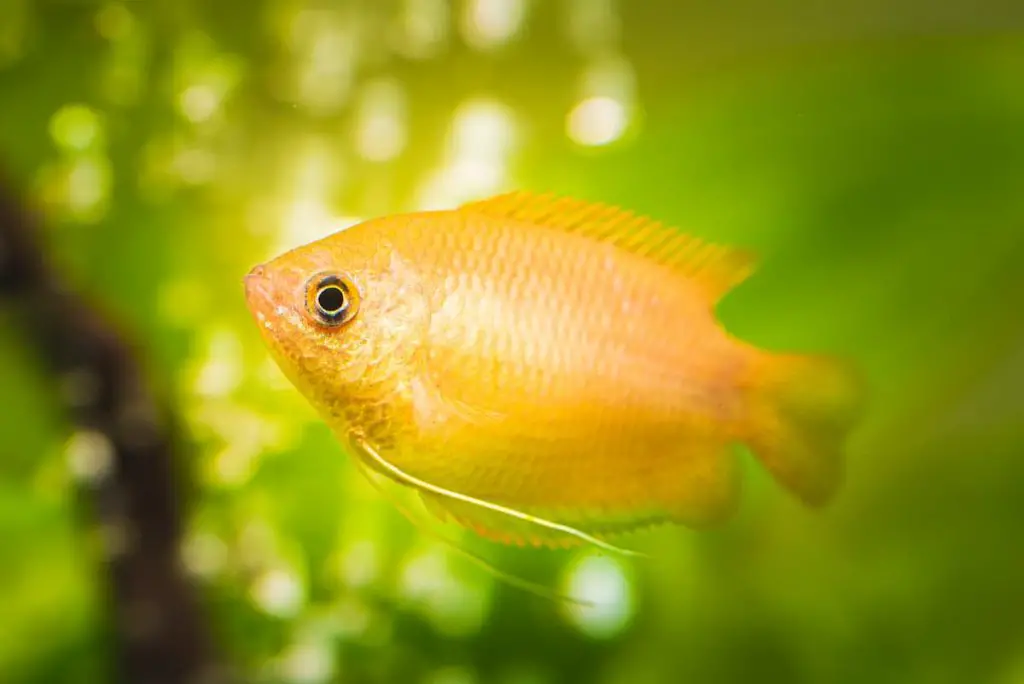
Initially, this small labyrinth fish was miscategorized as two different species, since the male and the female of the species look a bit different from each other.
Later, it was understood that both are the same, and the name Honey Gourami stuck because of the beautiful caramel-honey coloring.
The fish were given their scientific name because it basically means “hairy stomach,” which describes the looks of their long, narrow ventral fins.
The species of freshwater fish is normally found in the lakes and rivers in certain areas of India and Bangladesh, and occasionally in Nepal. Their natural habitats have soft, poorly mineralized water, with thick vegetation.
The fish has become popular in the fishkeeping community, thanks to its lovely warm shades and interesting personalities. They have, however, gone through some genetic fiddling.
Scientists have selectively bred some strains with improved coloration. These are often confused with the Dwarf Gourami.
Honey Gourami have narrower bodies and smaller anal fins and dorsal fins, and their ventral fins are narrow and thread-like (thus the “hairy” part of their name).
They’re a peaceful, hardy fish, meaning they’re great for newbie aquarists.
The fish aren’t terribly out-going, but they do well with up to six of their own kind stocked together. They’ll probably establish a hierarchy in the fish tank, though, which comes out during their feeding times.
The fish has a labyrinth organ, meaning they can breathe in poorly oxygenated water, which is probably part of why they’re such great fish for newbie hobbyists getting a handle on water parameters, aeration, etc.
The males and females start life the same color as each other, but as they mature, the males develop a more honey-coloring, ultimately resulting with them bright honey-yellow or reddish-orange.
The face, belly, and throat on the males will also darken into a dark blue or bluish-black.
You can find these bright little fish online for purchase.
Optimal Water Conditions for Honey Gourami
| Water Temperature: | 71-82°F |
| Water Flow Rate: | slow-moving |
| pH: | 6.0-7.5 |
| Water Hardness: | 4-15 dGH |
Tank Setup
| Minimum Tank Size: | 10 gallons per each |
| Optimal Tank Size: | 15 gallons per each |
| Optimal Tank Shape: | Standard rectangular tanks |
| Recommended Filter Type: | External filters |
Honey gourami, though hardy, need water that has only smaller water chemistry changes. They do need regular water changes of 25% weekly, with a solid, external filtration system in place.
Their labyrinth organ is very sensitive to water temperature changes, and that’s probably the most difficult aspect of keeping these fish.
Ideally, you’ll keep the aquarium housing your honey gourami in a room that’s about the same temperature as the water.
Author note: Most of us can’t do that, however, so you’ll need to find a quality water heater that will keep their tank water between 71 and 82 degrees Fahrenheit.
They need soft water that’s slow moving and the fish tanks themselves need to be 10 gallons per fish, or 20 gallons per pair.
Each additional fish should have an extra 5 to 10 gallons of water. In other words, if you’re keeping 4 fish, you’ll need a minimum of 30 gallons, ideally 40 gallons.
Creating the Landscape for honey gourami
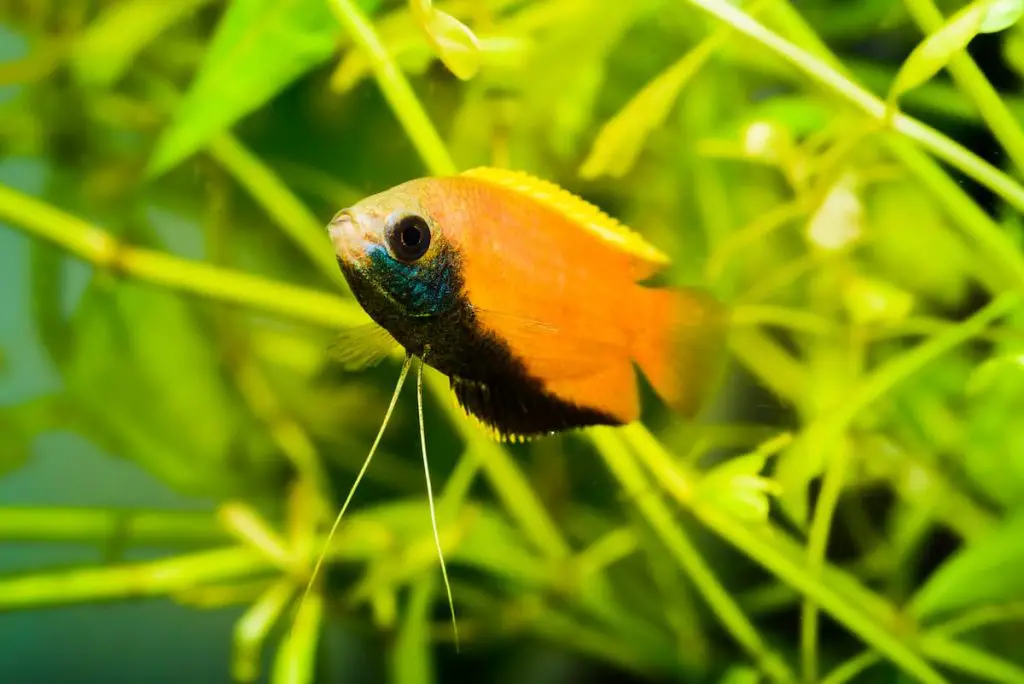
Honey gourami are shy fish, so they need a lot of places they’ll feel secure and safe, especially if there are other fish housed in the same tank with them.
To provide them with this sheltering, you’ll want to include a lot of live plants (though be careful not to overplant!), some floating plants, and some decorations like flower pots or caves.
And maybe even a 3D background with “ledges” for them to hide in and among – a pure treasure for these fish.
Top tip: Leave the surface uncovered, though, meaning just some floating plants, but not tons. Because these fish have labyrinth organs, they often rise to the surface to breathe air.
Some of the best plants to include in your honey gourami tank are hornwort and water wisteria.
| Best Plants: | Java moss, water sprite, water wisteria, hornwort, crystal wort, water lettuce |
| Best Lighting: | Moderate |
| Best Decorations: | Live plants, flower pots and caves, 3D background, whatever substrate best suits the plants you choose |
| Decorations to Avoid: | Anything with jagged or sharp edges, anything that totally blocks the surface of the water |
Physiological Considerations for Honey Gourami
| Size: | typically 2 inches, may reach 3 inches |
| Lifespan: | 4-8 years |
| Temperament: | Peaceful |
| Preferred Tank Region: | Top and middle |
| Scale Thickness: | Nothing of note. |
| Gill Considerations: | Honey gourami have both gills and a labyrinth organ. They require clean water, but they will also breathe air from the surface of the water. |
| Swimbladder Considerations: | Usual concerns for swim bladder. Avoid overfeeding, keep their tanks clean, and make note of any belly bloat or lethargy. |
| Fin Shape Considerations: | They should not be housed with fin nippers. |
Honey gourami, or sunset gourami as they’re often called, have a labyrinth organ, meaning they breathe both in the water with their gills and in the air at the surface of the water.
For this reason, they tend to hang out in the middle and top regions of the tank and they don’t really have a preference about substrate.
Most aquarium honey gourami are bred in captivity at this stage, and many of them have descended from genetically enhanced fish. These were messed with by scientists to brighten the coloration of the fish.
Honey gourami, on average live between 5 and 8 years. Of course, things like care quality and genetics of the specific fish will alter that, just like it does in humans, cats, or any other living creature.
The fish tend to be pretty hardy, but they do have some needs that must be met, like a consistent water temperature change and only mild water chemistry changes.
Most folks notice the vivid yellow array of coloration in the male honey gourami. They can be anywhere from a pale honey yellow to a vivid reddish-orange. The females are significantly more muted.
The males also have a bluish silver that disappears under the belly and their fins are typically a lighter yellow to deep orange. Females, on the other hand, have a fairly silver color with light gray fins.
Both genders have a similar body shape and overall, the fish can grow to be up to 2-inches in size, normally. In some exceptional cases, they may grow to be closer to 3-inches in length. Females tend to be just a little bit larger than males.
Society of honey gourami
These little fish are peaceful and shy, which means they get along well with each other, but you’ve got to be careful which other fish and critters you keep in with then.
Author note: First off, fin nippers should be kept out. They go after the honeys and this stresses the fish out and may lead to long-term health concerns.
You should also avoid housing them with aggressive fish. You’ll never get to see these shy little guys if aggressive or overly active fish are around!
They also won’t get to eat because the more active fish will compete – and beat – them out for food.
Specifically, you’ll want to avoid larger catfish, silver dollars, pacus, and Oscars, and those famously aggressive bettas. Avoid fin nipping tiger and clown barbs, as well.
Fish with compatibility with these little guys are going to be other peaceful fish like danios and peaceful barbs. They do well with small loaches, like Kuhlis, and small catfish like Corydoras.
Don’t keep them with shrimp, either, as they’ll eat them.
If you want some critters to help clean things up, snails make for excellent tank mates for honeys.
The best tank mates for these little beauties, however, is going to be other honey gourami. They tend to pair off, though, so keep them in pairs, rather than excepting schools. Ideally, keep 4 to 6 of them together.
Fish to consider as tank mates include:
- Harlequin rasboras
- Corydoras
- Neon tetras
- Ember tetras
- Sparkling gourami
- Kuhli loach
- Clown loach
- Danios
- Small, peaceful barb species
- Snails
- Guppies
- Mollies
- Zebra danios
Gender, Breeding, and Reproductive Considerations
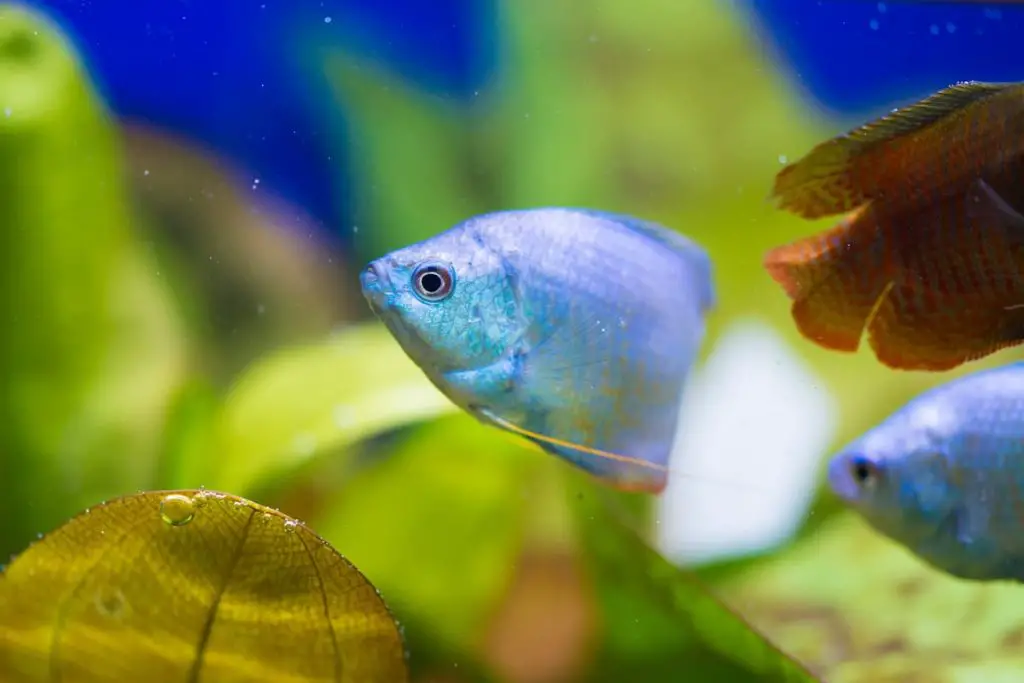
Breeding your honey gourami at home is absolutely a possibility. They will need the right conditions, of course, but those aren’t too hard to create.
First off, you’ll need to identify your potential breeding pairs. Remember that the females are silvery in color while the males are the vividly colored ones. This, at least, makes the pairing off reasonably easy.
We recommend using a breeding tank for the process to help ensure the breeding cycle, hatching, etc. are all in the best situations for success. A 15-gallon tank is generally large enough, but if you’ve got a larger tank, that will do even better.
Raise the water temperatures to slightly higher than normal, in the 78 to 82 degree range. This helps to encourage the fish to spawn.
Top tip: Also, have the water shallower than you would normally have it. This also helps the maximum possibilities arise. Add in a gentle sponge filter to keep conditions healthy for them.
These fish make bubble nests, so make sure there are some plants in the breeding tank as well. Males will create the nest and then start showing off.
He’ll be whizzing around and bumping into the female pretty often as his “mating dance” for her.
If the female decides she’s reasonably impressed, she’ll release her eggs (about 20 of them) for him to fertilize them. He’ll fertilize them and then start moving them with his mouth into the nest.
This will repeat until about 300 eggs total have been fertilized.
As soon as this happens, though, you’ll need to remove the female from the tank. Males gets overly protective once the eggs are released and they have been known to attack the females for getting too close the nest.
The eggs will hatch somewhere between 24 and 36 hours after they’ve been fertilized. The male adult should then be removed from the tank.
Once the fry have hatched and are able to swim around on their own (usually taking about 3 days), you’ll want to start feeding them brine shrimp and artemia or infusoria to help them grow.
Nutritional Needs
The honey gourami has a unique way of catching its food in the wild.
They position themselves carefully to watch for prey at the surface of the water, then when their prey (insects) come within range, they squirt water at them, knocking them down into the water. Then the fish eat the prey quickly.
In the wild, honey gourami are omnivores, eating small invertebrates, zooplankton, insects, and some plants. Because of this, you need to choose resilient plant species to avoid them fish from killing them.
In your aquarium, honey gourami are willing eaters. They love fresh food, though, and some low-grain/no-grain fish flakes.
It’s important that their foundational diet is built on these healthy flakes with live foods, and then things like bloodworms and brine shrimp, vegetable tablets, and others as supplements.
They’re not fussy, so it’s not hard to give them a complete and balanced diet.
They should be fed once or twice per day, in a 2-3 minute feeing period each time only. Remove any excess food to avoid overfeeding or rotting food from damaging the water chemistry and harming your fish.
Top tip: Most folks feed them in the morning and in the evening, but you may opt to feed them only once per day if your schedule doesn’t allow for two feedings.
The best foods for honey gourami include:
- Algae wafers
- Bloodworms
- Brine shrimp
- Freeze-dried brine shrimp
- Freeze-dried bloodworms
- Algae-based flake food
- Tubifex
| Best Sustenance Food Type: | algae-based flakes, bloodworms, brine shrimp |
| Additional Food For Optimal Health: | algae wafers, tubifex, additional protein sources vegetable tablets |
| Special Foods and Considerations for Best Color and Growth: | Solid, balanced diet of both protein and vegetation |
| When and How Often to Feed Fish Based on Life Cycle: | They should be fed once or twice per day – based on your schedule, for 2-3 minutes per feeding only. Remove any excess food from the water. |
Common Diseases and How to Avoid and Treat Them
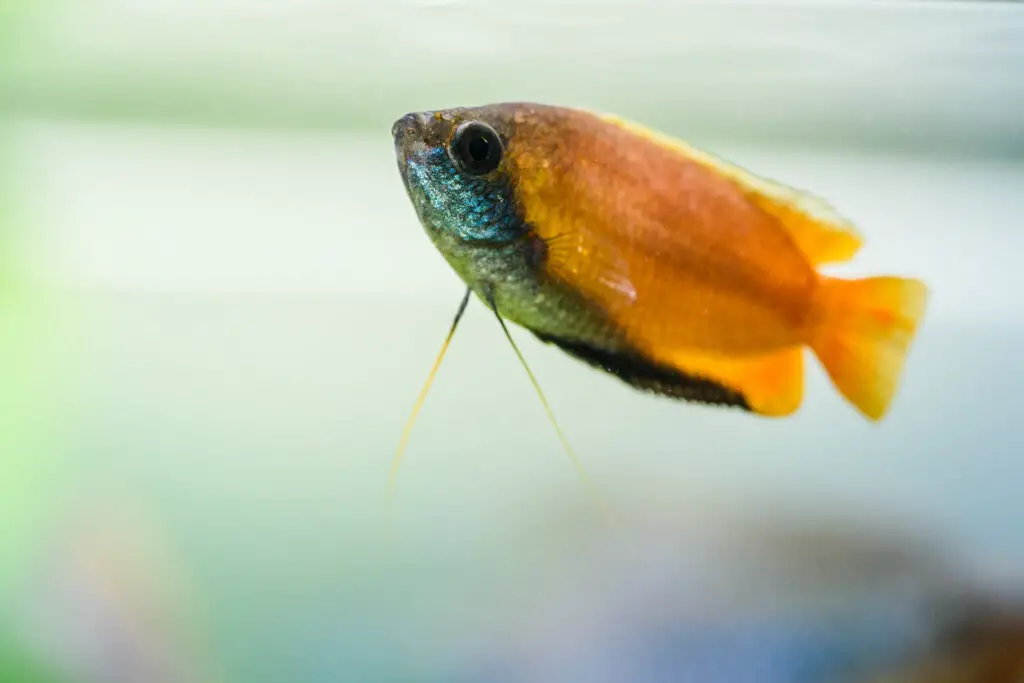
These fish are pretty resilient, but they do need that weekly water change of 25% to avoid health issues.
And if those parameters are maintained and the water remains clean, most of the ailments that these little guys are susceptible to won’t create problems.
However, there are some diseases and conditions to be aware of and look out for symptoms of in your fish.
Velvet Disease
Honey gouramis are prone to a parasitical infection known as velvet disease. The parasite, Oodinium pilularis, can live in the gills, skin and mouth of your gourami.
If the parasites are present, the fish will have a brownish, maybe golden, “dust” over their fins and body. The spots are small enough, though, that you may not even see them before the fish is beyond help.
So, keep an eye out for these other symptoms.
- Scratching their bodies against hard objects
- Weight loss and loss of appetite
- Lethargy
- Labored or rapid breathing
- Fins clamping close to the body
- Peeling skin
To treat this disease, you’ll need to raise the water temperature and dim the lights for several days. Add some aquarium salt and treat with copper sulfate for ten days.
If you’re using carbon in the filter, discontinue use of that for the duration of the treatment.
Hole in the Head Disease
Hole in the Head, lateral line erosion, or Hexamita may be identified by ulcerations or “holes” that develop in the fish’s head or along the lateral line of the body of the fish.
This disease can be caused by either a virus or by a protozoan hexamita. Some believe it may be caused by severe stress as, by an autoimmune response, or as a dietary deficiency.
Most commonly, it’s found in overcrowded tanks with poor water quality.
To treat this disease, immediately perform a partial water change. This may be enough to see improvements quickly.
If the water changes don’t show improvement quickly, the disease may be caused by the hexamita, which means the fish will likely need to be treated with metronidazole (Flagyl).
This is an over-the-counter solution that can be found at most pet stores.
Ich
The other most common disease faced by honey gourami is ich, or white spot disease. To treat ich, you’ll need to do that partial water change of at least 25% and treat them with medications like Aquarisol.
Maintain the proper water chemistry throughout treatment, and isolate any fish who are not getting better as quickly as others.
Prevention of These Diseases
Prevention of all these diseases can strongly be done through:
- Quarantine any new fish or invertebrates before introducing them into the aquarium
- Provide a well-balanced, nutritionally viable diet
- Maintain high water quality
| Best Antibiotics: | Aquarisol, Flagyl, copper sulfate |
| Treatments to Avoid: | Nothing of note |
| Food Recommendations When Sick: | Balanced nutrition with protein-rich foods and vegetation |
| Hospital Tank or Isolation Withing the Community Tank: | Isolate fish in an isolation tank if only one fish shows symptoms |
4 Facts About Honey Gourami
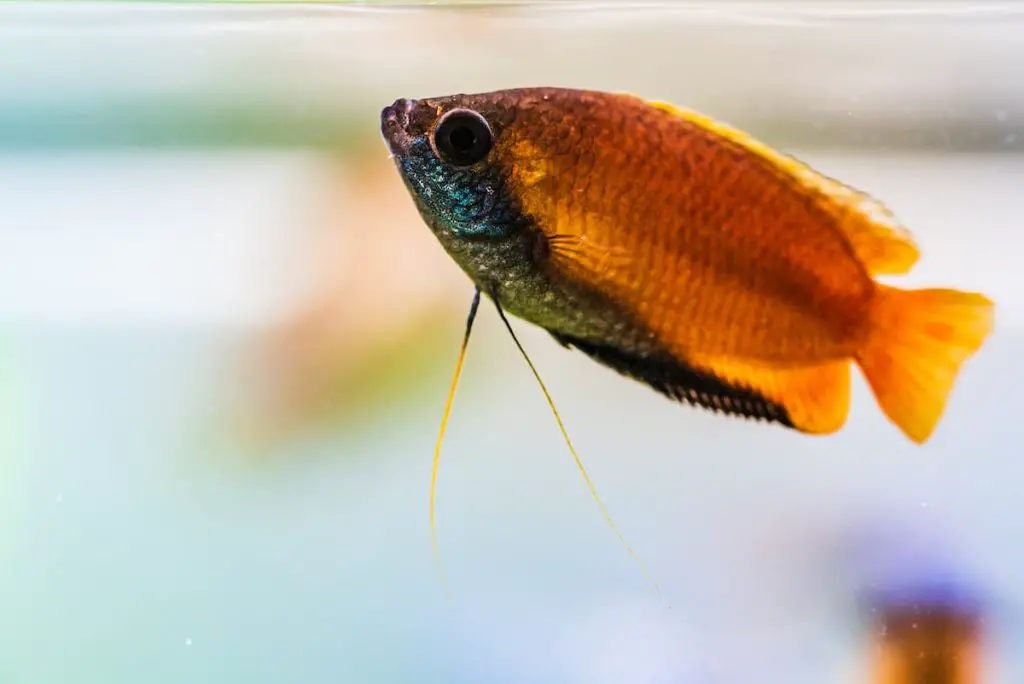
- In 1882, Francis Hamilton misidentified the male and female Honey Gourami as two different species! The color differences in the sexes made him inaccurately assume the two were different species, so he named the male Trichopodus chuna and the female Trichopodus sota.
- The Honey Gourami and the Dwarf Gourami are closely related, but they are not the same species. The confusion on the two comes because the coloring of the fish inside retail stores tends to be bland (in either gender) – and this means they can both be confused with the female Dwarf Gourami.
- The mild coloring of the fish is where they get the name “Honey.” This is typically the color observed in the males.
- Food and environment features can enhance the color of Honey Gourami, so be sure to take especial care for those things!
Are Honey Gourami Right for You?
You’ve had a good look at the care, feeding, and even breeding options for honey gourami. Now, it’s time to consider: are these fish for you?
The peaceful, colorful fish are great for inexperienced fishkeepers and handle many of the mistakes newbies make.
They’re beautiful, interesting and quirky with unique habits like bubble nesting and water spitting at prey and they do add some unique color and intrigue to that tank.
They’re good for placing in paludariums, blackwater tanks, and other unique setups that can really add some interest to your fishkeeping hobby.
But they also prefer densely planted tanks and they enjoy lots of hiding places. And because they are peaceful, they need very specific tankmates to help them stay healthy and safe.
Is your aquarium good for meeting these kinds of needs? Are you starting a new tank and looking for a focal point for your aquatic pets?
Honey gourami are stunning, easy to care for, and fun – so they just might be the perfect choice for you, no matter your skill and experience level.
